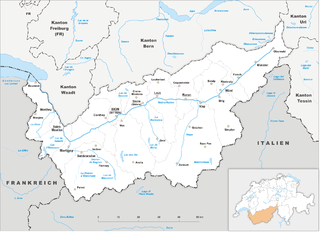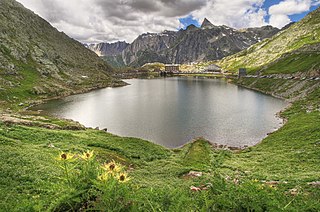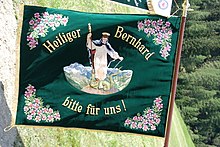
The Pennine Alps French: Alpes Pennines, Italian: Alpi Pennine, Latin: Alpes Poeninae), sometimes referred to as the Valais Alps, are a mountain range in the western part of the Alps. They are located in Italy and Switzerland (Valais).
Saint Bernard refers primarily to Bernard of Clairvaux (1090–1153), a Christian saint, mystic, and reformer of the Cistercian order.

Valais, more formally the Canton of Valais, is one of the 26 cantons forming the Swiss Confederation. It is composed of thirteen districts and its capital and largest city is Sion. The flag of the canton is made of thirteen stars representing the districts, on a white-red background.

The Great St Bernard Pass is the third highest road pass in Switzerland, at an elevation of 2,469 m (8,100 ft). It connects Martigny in the canton of Valais in Switzerland with Aosta in the region Aosta Valley in Italy. It is the lowest pass lying on the ridge between the two highest mountains of the Alps, Mont Blanc and Monte Rosa. It is located on the main watershed that separates the basin of the Rhône from that of the Po.

The Little St Bernard Pass is a mountain pass in the Alps on the France–Italy border. Its saddle is at 2188 metres above sea level. It is located between Savoie, France, and Aosta Valley, Italy, to the south of the Mont Blanc Massif, exactly on the main alpine watershed. There is also a Great St. Bernard Pass, famous for giving the St Bernard breed its name, and a San Bernardino Pass.

The St. Bernard or Saint Bernard is a breed of very large working dog from the Western Alps in Italy and Switzerland. They were originally bred for rescue work by the hospice of the Great St Bernard Pass on the Italian-Swiss border. The hospice, built by and named after the Alpine monk Saint Bernard of Menthon, acquired its first dogs between 1660 and 1670. The breed has become famous through tales of Alpine rescues, as well as for its large size and gentle temperament.

The Via Francigena is an ancient road and pilgrimage route running from the cathedral city of Canterbury in England, through France and Switzerland, to Rome and then to Apulia, Italy, where there were ports of embarkation for the Holy Land. It was known in Italy as the "Via Francigena" or the "Via Romea Francigena". In medieval times it was an important road and pilgrimage route for those wishing to visit the Holy See and the tombs of the apostles Peter and Paul.

Fiacre is the name of three different Irish saints, the most famous of which is Fiacre of Breuil, the priest, abbot, hermit, and gardener of the seventh century who was famous for his sanctity and skill in curing infirmities. He emigrated from his native Ireland to France, where he constructed for himself a hermitage together with a vegetable and herb garden, oratory, and hospice for travellers. He is the patron saint of gardeners.

Gotthard, also known as Gothard or Godehard the Bishop, was a German bishop venerated as a saint.
Canons regular are priests who live in community under a rule and are generally organised into religious orders, differing from both secular canons and other forms of religious life, such as clerics regular, designated by a partly similar terminology.

The Diocese of Sion is a Latin Catholic ecclesiastical territory in the canton of Valais, Switzerland. It is the oldest bishopric in the country and one of the oldest north of the Alps. The history of the Bishops of Sion, of the Abbey of St. Maurice of Valais as a whole are inextricably intertwined.

Barry der Menschenretter (1800–1814), also known as Barry, was a dog of a breed which was later called the St. Bernard that worked as a mountain rescue dog in Switzerland and Italy for the Great St Bernard Hospice. He predates the modern St. Bernard, and was lighter built than the modern breed. He has been described as the most famous St. Bernard, as he was credited with saving more than 40 lives during his lifetime, hence his byname Menschenretter meaning "people rescuer" in German.

The Diocese of Annecy is a Latin Church diocese of the Catholic Church in France. Saint-Gingolph VS, a town in the Swiss canton of Valais, is also part of the diocese. Originally erected in 1822, after the Concordat as a subdivision of the Roman Catholic Archdiocese of Chambéry, the diocese comprises the entirety of the department of Haute-Savoie in the Region of Rhône-Alpes. Only recently, in 2002, did the metropolitan change. The diocese is now suffragan to the Archdiocese of Lyon. The current bishop is Yves Le Saux, appointed in 2022.

Mont Vélan is a mountain of the Pennine Alps, located on the border between Switzerland and Italy. At 3,727, metres Mont Vélan is the highest summit lying between the Great St Bernard Pass and Grand Combin. Two large glaciers cover its northern flanks: Glacier de Tseudet (west) and Glacier de Valsoray (east). The Glacier de Proz, lying on the west side, was traversed during the first ascent.

The Great St Bernard Tunnel is a road tunnel complementing the Great St Bernard Pass, linking Martigny with Saint-Rhémy-en-Bosses.

The Great St Bernard Hospice, named after its founder Bernard of Menthon, is a hospice and hostel for travelers at the Great St Bernard Pass in Switzerland. At an elevation of 2,469 m (8,100 ft) in the Pennine Alps, it is located a few hundred metres north from the border with Italy. It is part of the municipality of Bourg-Saint-Pierre in the Swiss canton of Valais.

Hugh of Noara or of Novara, also known as Ugo of Novara and Hugo of Novara, was a Cistercian monk and a disciple of Bernard of Clairvaux. French by birth, he served as the first abbot of Novara Abbey, Sicily, where he remained until his death in 1170.

Great St Bernard Lake is a mountain lake of the Pennine Alps, located south-west of Great St Bernard Pass. It is divided between Switzerland and Italy, although it lies south of the Alps, within the Dora Baltea basin.
Joseph Vaudan was a Catholic priest in the Order of St. Barnard responsible for the birth of commercial wine making in Valle d'Aosta, Italy, and one of the earliest directors of the Institut Agricole Regionale (IAR) in Aosta in Italy's Valle d'Aosta following World War II.
Pierre or Pietro Chanoux was a French Benedictine monk in charge of a mountain convent and hospice. He was an amateur botanist who started a garden of alpine plants, still maintained as the Chanousia Alpine Botanical Garden located at located at 2170 meters altitude near Mont Blanc, at the Little St Bernard Pass in France, but maintained by the frontier Italian commune of La Thuile.



















